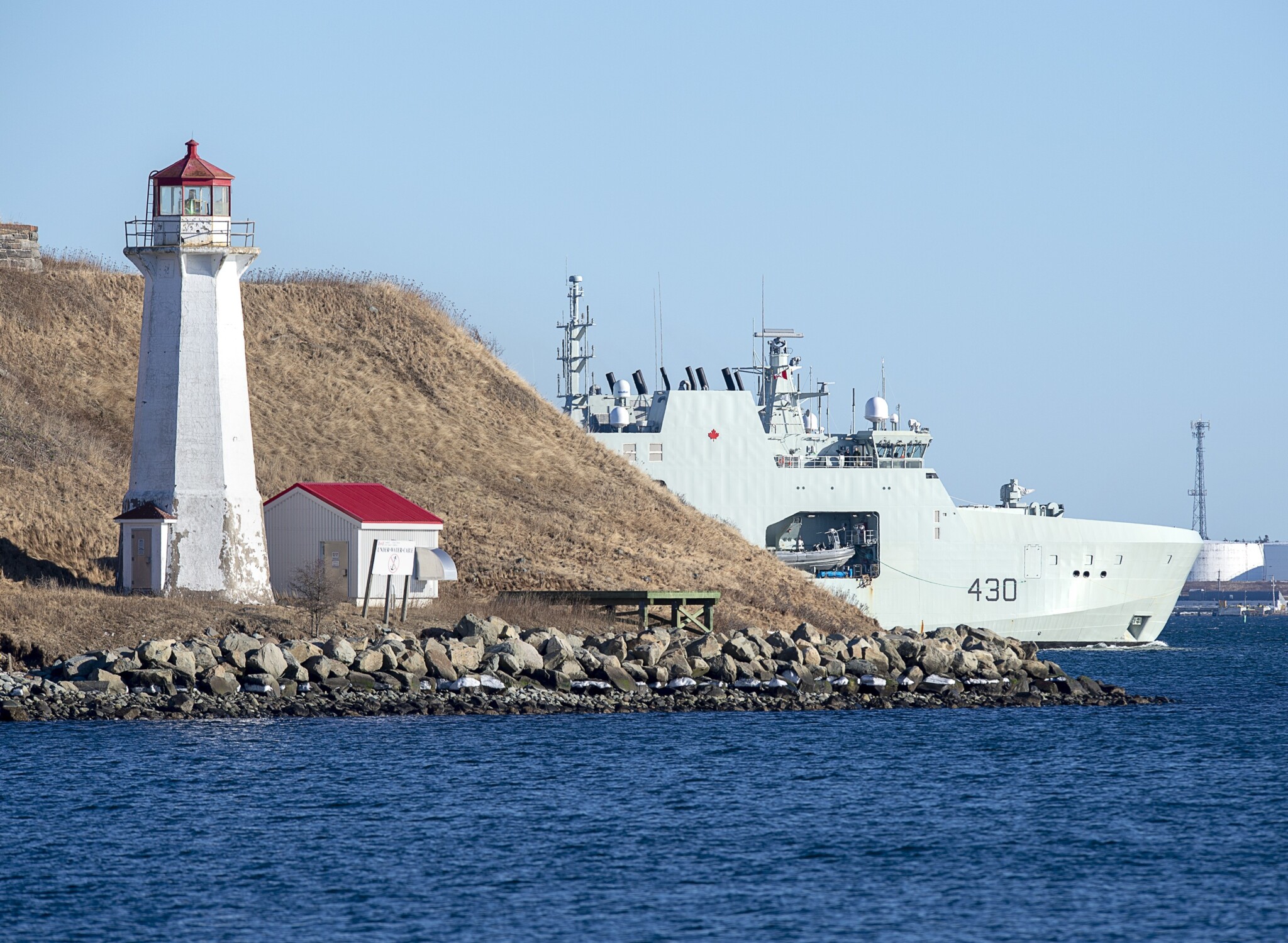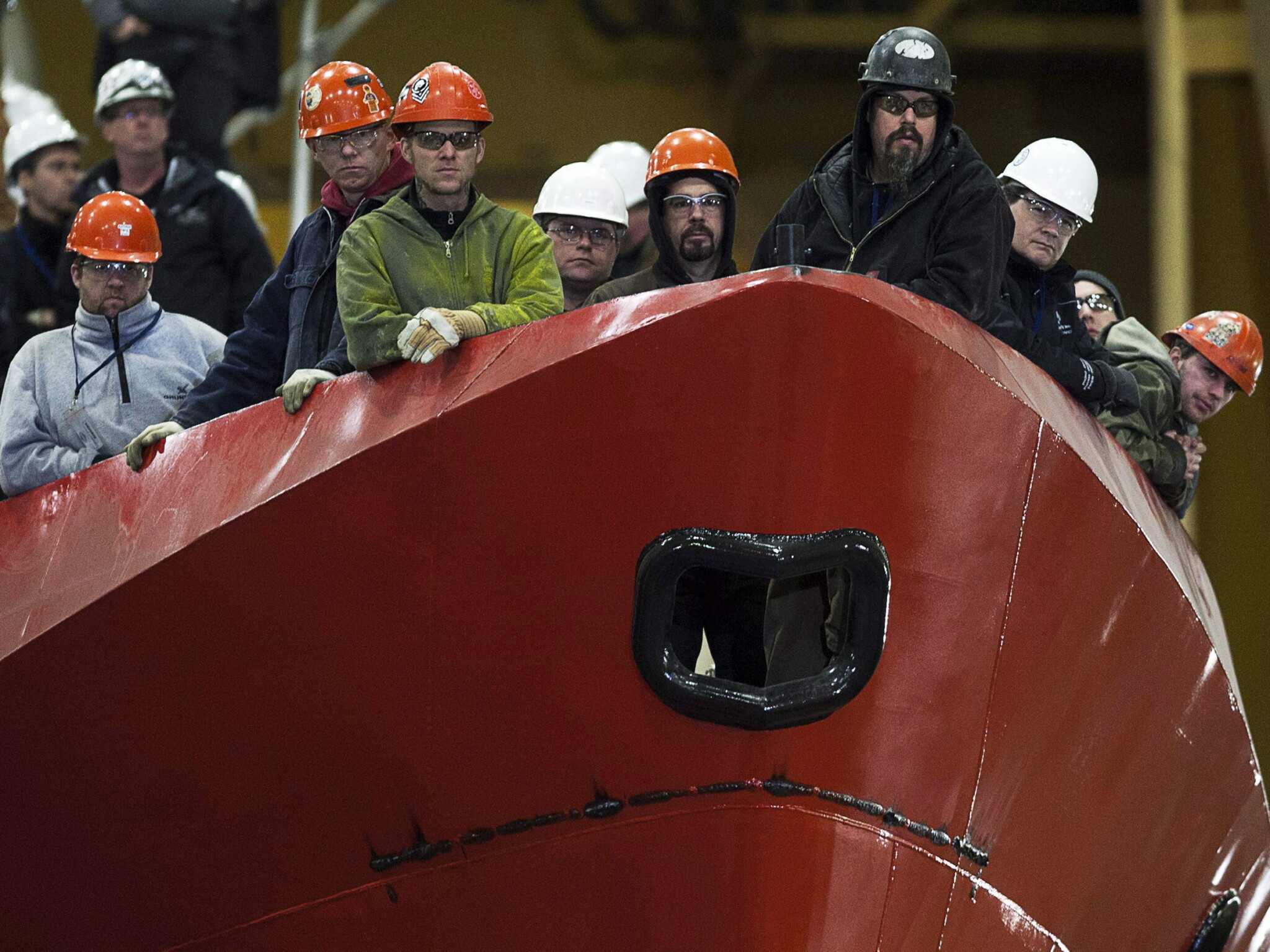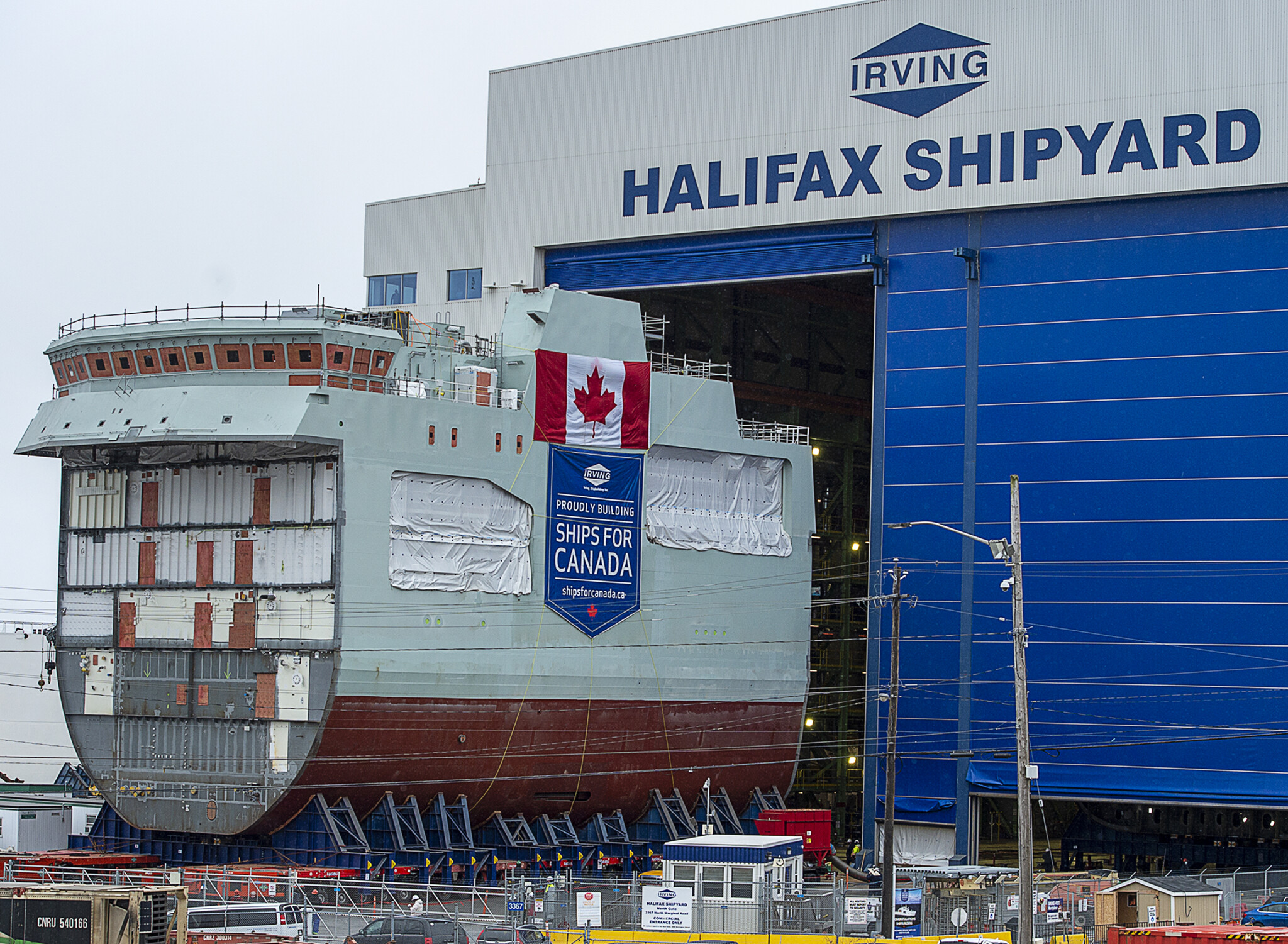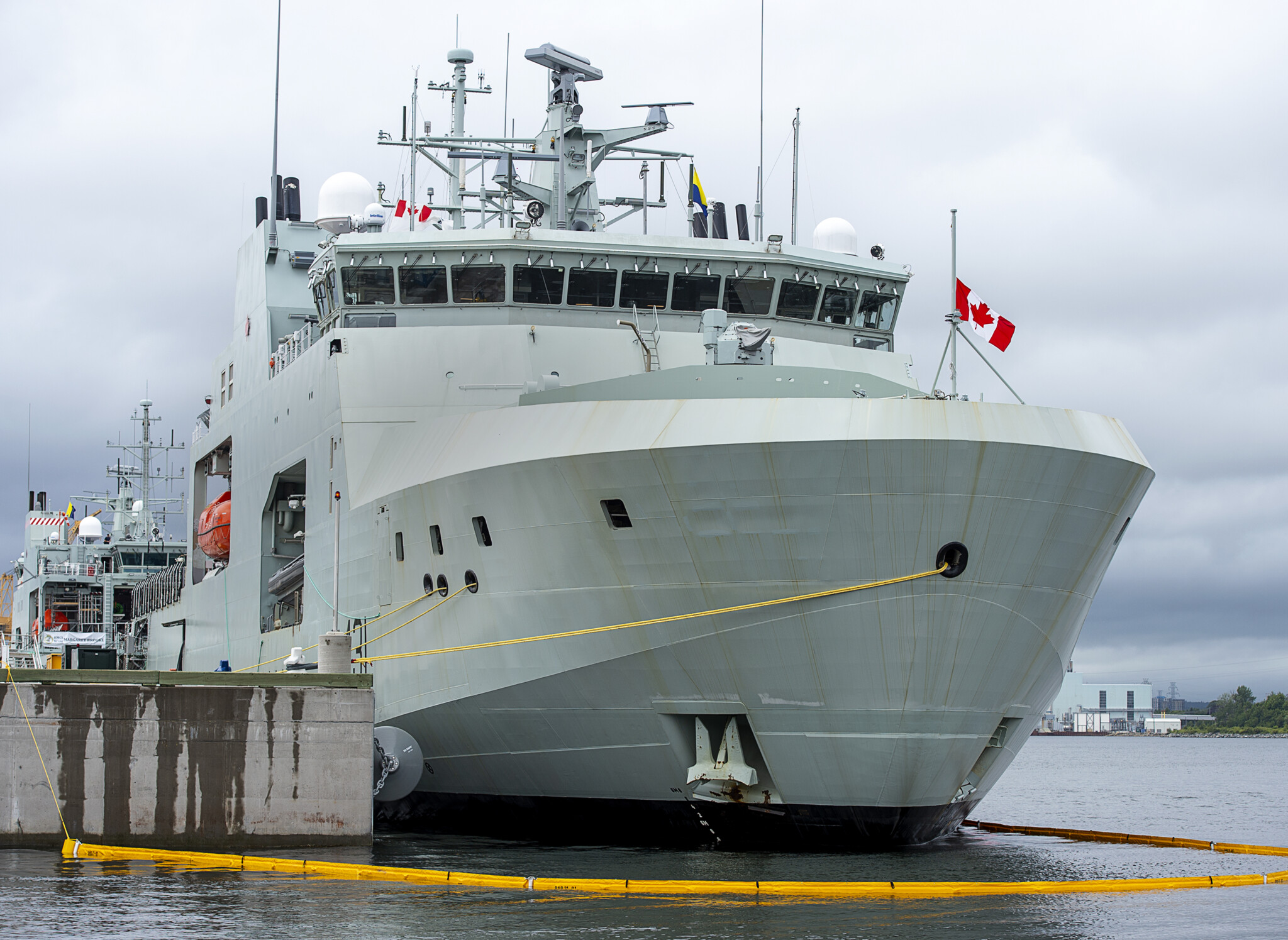DeepDives is a bi-weekly essay series exploring key issues related to the economy. The goal of the series is to provide Hub readers with original analysis of the economic trends and ideas that are shaping this high-stakes moment for Canadian productivity, prosperity, and economic well-being. The series features the writing of leading academics, area experts, and policy practitioners. This particular DeepDive is made possible by Irving Shipbuilding and readers like you.
The common narrative of Canada’s economic history is that our economy is dominated by a mercantilist system—to paraphrase Canadian economist Harold Innis’s famous thesis, the local economy was limited to hewers of wood and drawers of water, with complex manufacturing of finished goods occurring back in Europe and later the United States.
Yet there was one clear exception to this: shipbuilding, which emerged as the colony’s first true complex industrial activity as far back as the mid-17th century. As a colonial power, France actively encouraged the sector’s development by taking advantage of abundant, high-quality timber from Canadian forests, an immigration policy that targeted shipwrights and other skilled workers, and private financing that often was a way to profits that were otherwise landlocked in the new colony. The vessels were essential for the development of the region’s economy—in terms of domestic investment and employment as well as for the export of goods to Europe. The production of warships followed soon after, with several second and third-rate vessels being procured by the colonial authorities.
Moreover, as the number of ships built in New France grew, their costs decreased—from 277 francs per ton to 177 per ton after five vessels. This represents a key insight about shipbuilding that’s still relevant today. There’s a learning curve effect: the more ships a yard constructs, particularly of a single class, the more efficient the workforce becomes at producing incremental vessels.

The future HMCS Harry DeWolf, the navy’s first Arctic and offshore patrol ship, built at the Irving-owned Halifax Shipyard, heads from the harbour in Halifax, Jan. 31, 2020. Andrew Vaughan/The Canadian Press.
But what would be a scenario repeated many times in the future, the industry underwent a significant downturn in 1763 with the Treaty of Paris that ceded New France to Great Britain. It severely curtailed demand for ships, and thus production suffered. It really wasn’t until the prospect of war with the United States in 1812 that there was a revival of Canadian shipbuilding, this time to construct naval vessels that could operate on the Great Lakes. The War of 1812 would kickstart a new shipbuilding boom that similarly relied on the abundance of wood and other raw materials but eventually came to be marked by the development of metal-hulled steamships, for which Canada had no innate advantages to build.
This same story has played out in the Maritimes, too. Nova Scotia’s shipbuilding industry similarly traces its roots to the 18th century, but it reached its first major boom during the so-called “Golden Age of Sail” in the mid-19th century. The province’s vast forests, natural harbours, and skilled labour force made it one of the leading shipbuilding regions in the British Empire. Towns like Lunenburg, Shelburne, and Pictou became synonymous with maritime craftsmanship.
By the 1870s, Nova Scotia was producing hundreds of wooden sailing vessels each year, many of which were sold internationally. This period not only drove economic prosperity but also helped define the province’s cultural and commercial identity. But it wouldn’t last. The global transition to steel-hulled, steam-powered ships rendered wooden shipbuilding increasingly obsolete, triggering the industry’s first major collapse by the turn of the 20th century.
The First and Second World Wars brought renewed urgency and investment to Nova Scotia’s dormant shipyards. Halifax and other coastal communities saw shipbuilding ramp up dramatically to meet wartime needs, including the construction of cargo ships, naval escorts, and supply vessels. The 1940s in particular saw the revival of once-quiet yards, with government contracts fuelling employment and industrial capacity. Yet each surge was followed by a steep contraction. As discussed later, when the wars ended, so too did much of the demand, and federal attention turned elsewhere. Without a long-term strategy or modernization, many yards closed again, leaving workers and communities to face familiar economic dislocation.
These three historical episodes are a reminder that the history of Canadian shipbuilding hasn’t been one of planned, sustained growth. Rather, it has been a constant cycle of boom and bust: periods of frantic production followed by a contraction as funding dried up. The booms were typically a result of major growth in naval fleet requirements by the Royal Canadian Navy and its allies, either due to war or the threat of it. The busts have usually come when government retrenchment isn’t offset by other sources of demand.
The costs of this boom and bust cycle aren’t limited to layoffs and bankruptcies. During the busts, accumulated specialized production knowledge is lost, which means that learning curve efficiencies disappear and costs are reset when production is restarted at a later date. Even a break of several months can be enough to disrupt the learning curve effects: displaced workers find alternative employment, and their unique experience and knowledge are lost.
The solution to the boom-bust cycle and its costly harm to learning curve efficiencies is what’s known as a policy of “continual build.” In basic terms, it refers to a long-term, sustained approach to naval vessel construction in which ships are built on a rolling, ongoing basis rather than in sporadic, one-off procurement cycles. The goal is to maintain skilled workers, industrial capacity, and cost efficiency over time.
The National Shipbuilding Strategy (NSS), launched in 2010 and updated in 2016, is an example of a continual build policy. By awarding multi-decade contracts to select yards, the strategy ensures a steady cadence of shipbuilding for the Royal Canadian Navy, Coast Guard, and federal agencies. Although it has had some issues over the past decade and a half, it represents a key policy innovation to build a modern, domestically anchored naval-industrial capacity in Canada. It has learned the right lessons dating back to the 17th century and is aiming to overcome the gaps and delays that break the continuity necessary for true industrial and strategic stability.
The purpose of this DeepDive essay is to put the NSS in a broader historical context and outline the economic and strategic importance of the continuous build model—with a particular focus on how it can lead to significant efficiency gains in the form of the capital and learning curves.
A brief history of the modern boom-and-bust cycle
Since 1900, there have been four major cycles. The first was the buildup to and during the First World War. Canada’s production was mostly limited to transport ships and small naval vessels, mostly for the Royal Canadian Navy (RCN). This boom would be short-lived: the end of the war saw a major contraction of the RCN and in turn orders for vessels. By 1929, the navy fleet consisted of only two destroyers and a few minelayers and less than 900 personnel of all ranks. With no orders and few vessels to refit, most yards closed down, and production ground to a halt. Between 1921 and 1939, no steel-hulled ocean-going vessels were built in Canada. And unlike the United States, the Canadian government did not use shipbuilding as economic stimulus during the Great Depression, which left it flat-footed for the upcoming war.

Workers construct components of the Arctic offshore patrol ships at the Irving shipbuilding facility in Halifax on Friday, March 4, 2016. Andrew Vaughan/The Canadian Press.
The start of the Second World War in September 1939 would launch the largest naval buildup and construction growth in Canadian history. Over the next six years, Canada would go on to produce 500 warships, nearly 800 cargo and auxiliary vessels, and 3,300 landing craft. From a prewar industry that probably employed fewer than 5,000 civilians, the shipbuilding workforce grew to 114,000 at its height, out of a population of just 11 million.
The end of the war would result in another major downturn, but it was not as severe as the one 20 years earlier. The Canadian navy was shrunk for the immediate peacetime needs, but there was a realization this time that the maintenance of a sizeable standing force was important. While a number of yard closures occurred, enough remained to enable the RCN to rebuild itself for the Cold War requirements after 1950. This rearmament program would produce t20 anti-submarine destroyers (The St Laurent class and its variations), as well as four heavier multipurpose destroyers (the Iroquois class).
Yet there was industry was beset by another bust cycle, as naval orders dried up after Pierre Elliot Trudeau’s dramatic reorientation of Canadian defence policy towards domestic defence and away from allied operations in the early 1970s. As a result, major capabilities were either cut or their replacements delayed.
For the RCN, there would be a 14-year hiatus between the final Iroquois-class destroyer delivery and the start of the Halifax-class production in 1989. The 12e were completed by 1996, and after the end of the Kingston-class maritime patrol vessel production two years later, warship production ceased again in Canada, leading to another bust cycle that lasted until the start of the Arctic Offshore Patrol Vessel (Harry De Wolf class) roughly 18 years later. As a result, much of the accumulated technical knowledge within the Canadian shipbuilding industry and within the Department of National Defence was lost.
This point is worth emphasizing: during this period, we saw the terminal decline of the Canadian civilian shipbuilding industry. A combination of competition from Asian competitors and declining domestic demand for large ships essentially ended the construction of large vessels. By 2000, the Canadian shipbuilding industry had contracted to something like just 5,000 employees.
There were various consequences to the declining capacity of the shipbuilding industry. One of the pernicious issues surrounding the boom-bust cycle is that the RCN, and the government more broadly, was forced to keep vessels in service beyond their expected design life. A rough rule of thumb is that naval vessels should be replaced after 25 years: after that point the maintenance costs rise dramatically. This can eat into procurement funding if the overall budget remains relatively flat, compounding the original problem of lack of funding.
In 2010, the government of Stephen Harper sought to end the shipbuilding industry’s ruinous cycle with the launch of the National Shipbuilding Procurement Strategy (now the NSS). The main objective of the program was to rationally organize the modernization of the Government of Canada’s entire fleet of military and civilian vessels for the next 30 years, including distributing the work among a small number of yards in order to generate learning curve efficiencies over time.
To this end, the government divided up work packages between combat and non-combat vessels, and undertook a competitive process to determine which yards would be allocated the work. combat vessel package, won by Irving Shipbuilding, would produce the already announced Arctic Offshore Patrol Vessel, and later replacement for the Halifax class—Canadian Surface Combatant. The non-combatant portion, won by Seaspan in the Vancouver area, would include the Joint Support Ship and many of the icebreakers for the Coast Guard.
The modern challenge of shipbuilding
One reading of Canada’s naval shipbuilding history is that the boom-bust cycle might be a sensible approach for balancing Canadian economic and military priorities during different times. The country was able to rapidly mobilize its economic potential to build ships.
Yet this interpretation fails to grapple with the unseen costs and consequences—particularly the learning curve effects. The efficiency costs from delays and gaps can be significant.
Those costs are even higher in the modern era. A rapid wartime transition for Canadian industry, like we saw in the lead up to the First and Second World Wars, would be infeasible today without a policy of continuous build. The nature of modern shipbuilding has been a far more complex industrial enterprise than in previous eras. It’s no longer an industrial capacity that a country can just turn on and off.
Changes in technology, as well as doctrine in modern warfare and the strategic environment itself, have fundamentally reshaped shipbuilding. Vessels are required to be much more well-rounded and possess cutting-edge capabilities, especially if they’re expected to operate in the Indo-Pacific against a much more capable China.

Workers look on from the bow of a ship as Prime Minister Stephen Harper addresses the crowd at the Halifax Shipyard in Halifax on Thursday, Jan. 12, 2012. Andrew Vaughan/The Canadian Press.
The increasing complexity of vessels impacts their construction in several different ways. The first is that shipyards must develop and maintain a diverse range of a highly skilled workforce. Many of these skill sets cannot be developed quickly and are often in high demand across the Canadian economy. A good example can be found in welders, a critical role within any shipbuilding program. It requires approximately three to four years of classes and an apprenticeship to bring welders to a basic skill level where they can undertake basic work, independent of oversight.
Yet welding on naval and coast guard vessels isn’t basic at all. It requires comparatively higher technical skill than the average across other parts of the economy. For example, their hulls use much harder steel—in part due to unique operational requirements. Icebreakers, in particular, often use exotic steel alloys like EQ-47, which retain their hardened properties in much colder climates that these vessels are expected to operate in.
They in turn require more exacting techniques that only more experienced welders are able to undertake successfully, which may take an additional three or more years to train individuals from scratch. The lack of expertise and talent can be highly costly. That was made plainly evident last year when 26 U.S. Navy vessels, including several submarines, were found to have defective welds across their hulls.
Furthermore, there are a number of skill sets that are unique to naval shipbuilding and must be developed and retained somewhere within the industrial enterprise. For example, a core part of these vessels’ capabilities is the electronics and sensors that are essential for carrying out missions. These systems often use programming and physical implementations that are limited to military applications and thus involve security clearances that benefit from continuity. These sorts of considerations are evident in almost all skill bases involved in the industry.
Beyond the workforce consideration, the increasing complexity of shipbuilding has affected the organization of the industrial enterprise, including the various inputs and overall supply chain. It harkens back to the relationship between lumber production and the early shipyards in the 17th and 18th centuries.
As with almost every other manufacturing sector in our modern economy, shipbuilding harnesses the productive efforts of thousands, if not tens of thousands, of different firms. Supply chain management has emerged as one of the most difficult aspects of shipbuilding today, which was laid bare during the COVID-19 pandemic and disruption to manufacturing industries.
The NSS should be understood as a response to these pressures. It aims to build the human and physical capital necessary to sustain a modern shipbuilding capacity in an era of rapid geopolitical and technological change.
The strategy’s recent history validates this approach. Irving’s example of transitioning from the construction of the Arctic Offshore Patrol Vessels to the River-class destroyers is a good one. The steady AOPV production line sustained a skilled workforce of thousands over nearly a decade. Irving’s Halifax Shipyard also underwent massive upgrades for AOPV construction, which is now being leveraged for the much more complex River-class ships. The government itself noted that each successive AOPV came with significant gains in production efficiency and process maturity that can now be leveraged for the other ships.

The future of continuous build
At present, the Canadian shipbuilding industry’s short to medium-term outlook looks strong. The government’s NSS has approximately 65 vessels being built with a displacement above 1,000 tons from the start of the program to 2040. Yet there should be concerns about its long-term prospects. The extended gestation of most Canadian naval programs alone risks the potential bust cycle risks reemerging.
There are several policies that Canada could pursue to address this issue. The first is to undertake an orderly modernization program and end the practice of operating ships beyond their planned design life. While the decision to extend service life often involves broader considerations—such as strategy and budgeting—committing to one in principle as part of the NSS would provide long-term stability. This would be particularly valuable past 2050, when the current generation of ships entering service starts to reach planned life.
Second, unlike the RCN of the past 50 years, the fleet design will change rapidly over the next two decades. While the River-class destroyers will be Canada’s primary surface combatant until late in the century, everything else will change significantly. Critically, it’s evident that any Western navy wishing to remain militarily relevant will employ a distributed range of capabilities in the maritime domain connected by robust networks: manned and unmanned sub-sea, surface, aerial, and space-based systems. Moreover, ships will need to be modular and ability to adapt to changing tactical, operational, and strategic circumstances.
The current commander of the RCN has highlighted two future combatant types that he would like to see the RCN field in the future. The first is a corvette—a type of warship that would be smaller than the River class and responsible for less demanding tasks, mostly around the Canadian coastline, as well as hemispheric roles. Currently, Canada uses the AOPS for some of these missions where it’s not ideally suited, like security patrols in the Caribbean.
The second is what is referred to as an arsenal ship, which would work in conjunction with the River class and other major surface combatants to provide what’s known as “magazine depth”—essentially a repository for more missiles and other munitions to support their operations. Other states are considering similar vessels of this type, often with an eye to being lightly or optionally crewed. Canada could be a leader in the development of this type of vessel, including leading the development of novel forms of doctrine and technologies that could further raise the domestic industry’s competitiveness in foreign markets, especially if built without American components that would enable its export to other navies. The Carney government’s announcement of significant new defence spending could involve, among other projects, dedicating a share of incremental resources to an arsenal ship.

The centre block of the future HMCS Max Bernays is moved from the fabrication building to dockside at the Irving Shipbuilding facility in Halifax on Friday, Jan. 22, 2021. Andrew Vaughan/The Canadian Press.
In order to incorporate these vessels into the continual build strategy, the Government of Canada would need to start these programs in the next few years, given the required lead times for development and production.
Furthermore, existing designs can be potentially modified to other roles by adopting iterative design practices. The current aversion to making serious alterations to existing designs should be loosened, allowing industry to keep designs up-to-date as they are being produced. This would keep the RCN at the cutting edge of naval warfare rather than risk receiving ships that are technically obsolete before they even hit the water. Vessels, particularly optionally or uncrewed ones, may be designed with shorter service lives and disposability in mind. This may help to bring greater “mass” to the RCN, while keeping the fleet technologically up to date with the constant replacement of older ships.
Finally, Canada can also look abroad for opportunities to fill out its shipbuilding order book. The North American naval shipbuilding industry remains under-capacity for its actual needs, especially in such complex geopolitical times. This has been particularly acute in the United States, which has been desperately trying to accelerate naval shipbuilding to meet global threats and yet has proven unable to meaningfully accelerate production due to a myriad of issues. The U.S. government has even looked at Asian yards to undertake refurbishment work on existing warships and the creation of the ICEPAK with Canada, Finland, and the United States for the construction of icebreakers. However, to take advantage of this potential opportunity, Canada must maintain the capacity to produce ships, especially ones that are competitive against foreign alternatives.
As noted at the outset, shipbuilding was likely Canada’s first advanced industry and provides a powerful legacy for the country’s future. Time and time again, Canadian shipyards have been called upon at the country’s time of need and delivered admirable results, only to face near extinction as government funding dried up.
Ending the boom-bust cycle and providing predictable, sustained orders would meet several key objectives: it would provide the RCN and other government agencies the ships they need to carry out their missions, which would provide security for the country. It would diversify the economy and create a pipeline of highly skilled trade workers in the populace, and would be an important innovation hub in the industry. Relying on this historical pillar of strength will be critical for Canada’s future.
This DeepDive was made possible by Irving Shipbuilding and the generosity of readers like you. Donate today.










